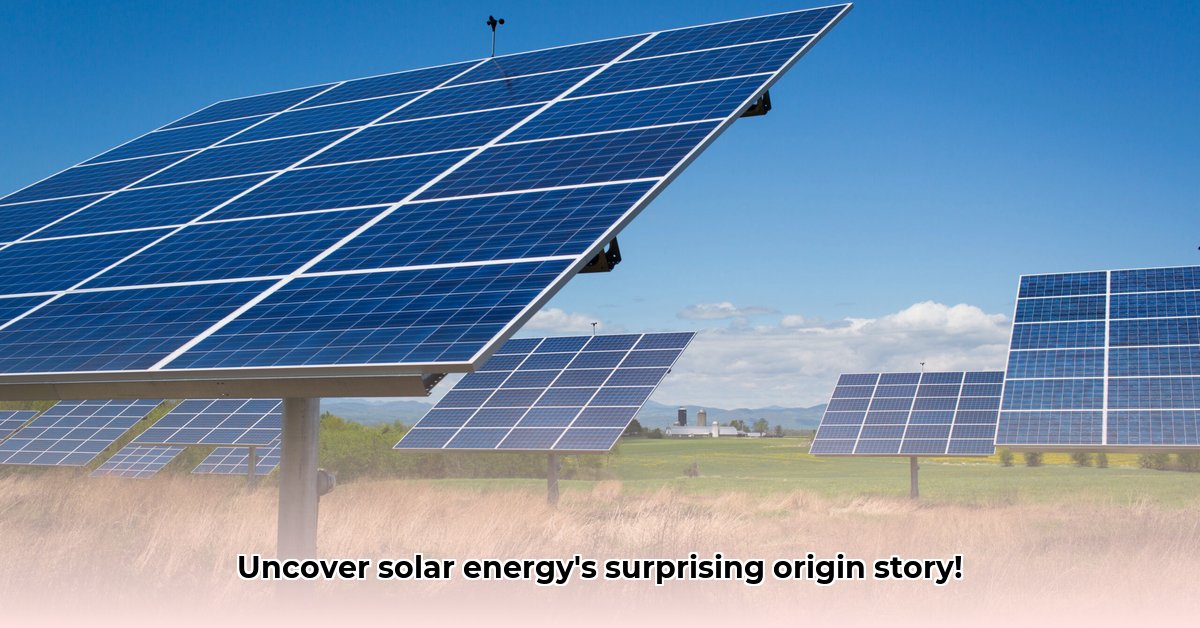Ever wonder how we transitioned from using sunlight to power simple devices to harnessing it for entire homes? The story of solar energy is a captivating journey through history, marked by brilliant minds, unexpected challenges, and continuous innovation. For a deeper dive into solar history, check out this resource: [Solar Energy History](https://txgenco.com/history-of-solar-energy). Far from a dry history lesson, we’ll explore the pivotal moments that have shaped solar power, from its earliest experiments to the cutting-edge technology we utilize today. We’ll also delve into comparing different types of solar cells and provide insights on how to consider solar panels for your home. Prepare for an illuminating exploration into the world of sunshine and energy!
When Was Solar Energy Invented? Exploring the Origins and Solar Breakthroughs
Harnessing the sun’s power might seem like something straight out of science fiction, but the invention of solar energy isn’t a single “aha!” moment. It’s a long, winding, multi-century narrative. Let’s delve into this fascinating history, focusing on solar panel origins.
The Spark: Unveiling the Photovoltaic Effect (PV) and Solar Origins
The story begins with understanding how sunlight can be converted into electricity. This phenomenon is known as the photovoltaic (PV) effect. In 1839, French physicist Alexandre Edmond Becquerel made a remarkable observation: shining light on certain materials created an electrical current. While this discovery was groundbreaking, it remained largely a scientific curiosity, requiring significant technological advancements to become practical for everyday use.
Early Attempts: Crude Solar Cells and Initial Solar Technology
In 1883, Charles Fritts created what could be considered the world’s first real solar cell, albeit an inefficient one. He coated selenium with gold. These early cells achieved only around 1% efficiency. The contrast between these early devices and the sleek, dark silicon panels adorning rooftops today is staggering.
The Silicon Revolution: Innovations in Solar Cell Technology and A Massive Leap Forward
A pivotal breakthrough occurred in 1954 at Bell Labs. Scientists Daryl Chapin, Calvin Fuller, and Gerald Pearson created a solar cell using silicon, marking a significant leap in efficiency, reaching 6%. While this may seem modest by today’s standards, it was a monumental advance, paving the way for practical applications of solar power.
From Outer Space to Earth: Space Exploration and Solar Energy: Early Applications
Initially, the high cost and relatively low efficiency limited the adoption of silicon solar cells to specialized applications where reliability and size were paramount. Satellites and spacecraft were early adopters, benefiting from solar power’s compact nature, regardless of expense. Did you know that in 1958, the Vanguard I satellite used a small, one-watt solar panel to power its radios, demonstrating the viability of solar energy in space?
The Cost Factor: The Long Road to Solar Affordability and Economic Viability
One of the biggest barriers to solar power adoption has always been cost. Early production methods made solar energy prohibitively expensive for most applications. However, technological advancements and economies of scale have dramatically reduced costs. Consider that in 1956, solar panels cost around $300 per watt. Today, they can cost as little as $0.50 per watt.
Government Support and Innovation: Policy Incentives Fueling the Fire
Government policies and incentives have played a crucial role in spurring the growth of the solar energy industry. Tax credits, research funding, and renewable energy mandates have encouraged investment and innovation. Concurrently, scientists have been relentlessly improving the efficiency of solar panels. Multi-junction solar cells, used in specialized applications, have achieved efficiencies approaching 40%.
The Future of Solar Power: Sustainable Energy Innovation: An Ever-Evolving Story
The history of solar energy is an ongoing saga of innovation and refinement. From Becquerel’s initial discovery to today’s high-efficiency solar cells, the journey has been marked by breakthroughs, challenges, and steady progress. Future advancements promise even greater efficiency, lower costs, and broader integration into our daily lives. Imagine future solar panels seamlessly integrated into building materials, clothing, and countless other applications. As we move toward a cleaner, more sustainable energy future, the possibilities are virtually limitless.
Timeline of Key Developments in Solar Energy:
| Year | Event | Significance |
|---|---|---|
| 1839 | Alexandre Edmond Becquerel observes the photovoltaic effect. | Discovered the fundamental principle of converting light into electricity. |
| 1883 | Charles Fritts creates the first selenium-based solar cell. | Demonstrated the first functional solar cell, although highly inefficient. |
| 1905 | Albert Einstein publishes paper on the photoelectric effect. | Explained the underlying physics, furthering scientific understanding. |
| 1954 | Bell Labs develops the first practical silicon solar cell. | Achieved significant efficiency gains, paving the way for broader applications. |
| 1958 | Vanguard I satellite uses solar panels. | Demonstrated the reliability of solar power in space. |
| 1977 | Creation of the Solar Energy Research Institute (now NREL). | Dedicated U.S. institution for advancing solar technology. |
| Present Day | Continued advancements in efficiency, cost reduction, and deployment. | Ongoing progress towards widespread solar energy adoption. |
This timeline reflects key milestones in the development of solar energy technology.
How to Compare Different Solar Panel Types for Home Installation: Solar Options
Key Takeaways:
- Monocrystalline panels lead in efficiency, while polycrystalline panels offer a cost-effective balance.
- Thin-film panels provide flexibility and lower initial costs, albeit with reduced efficiency.
- PERC technology enhances the performance of monocrystalline panels.
- Temperature coefficients affect panel performance in varying weather conditions.
- The best solar panel choice is determined by budget, roof characteristics, sunlight availability, and aesthetic preferences.
Understanding Your Options: A Solar Panel Deep Dive: Solar Selection Guide
Choosing the appropriate solar panels for your home can be daunting given the array of technologies available. Let’s explore the core types:
-
Monocrystalline Silicon: Fabricated from a single, pure silicon crystal, these panels are prized for their exceptional efficiency, converting a greater percentage of sunlight into electricity. However, they typically command a higher price.
-
Polycrystalline Silicon: Constructed from multiple silicon crystals, these panels offer slightly lower efficiency compared to monocrystalline options but are generally more affordable, making them a popular choice.
-
Passivated Emitter and Rear Cell (PERC): PERC technology enhances the efficiency of monocrystalline panels by enabling them to capture more light. This leads to increased power output from the same surface area.
-
Thin-Film Solar Panels: These panels are manufactured by depositing thin layers of photovoltaic material onto a substrate. They’re flexible, lightweight, and often less expensive than crystalline silicon panels but have lower efficiency.
Making the Right Choice: Solar Investment Strategy: A Step-by-Step Guide
-
Assess Your Energy Needs: Determine your household’s energy consumption to calculate the necessary size of your solar system.
-
Evaluate Your Roof: Assess your roof’s suitability, considering its angle, orientation (south-facing is optimal in the Northern Hemisphere), and any potential shading.
-
Set Your Budget: Establish a budget, recognizing that solar panel systems vary considerably in cost.
-
Compare Panel Specifications: Scrutinize efficiency ratings, power output, and temperature coefficients. Higher efficiency doesn’t automatically guarantee the best overall value.
-
Get Multiple Quotes: Obtain quotes from at least three reputable solar installers to compare pricing, warranties, and included services.
-
Consider Aesthetics: Evaluate the appearance of the panels. Monocrystalline panels typically have a sleek, black aesthetic, while polycrystalline panels often appear blue.
-
Check for Guarantees and Warranties: Ensure that both the manufacturer and installer offer comprehensive warranties covering performance and materials.
Pros and Cons: Panel Performance: A Quick Comparison
| Panel Type | Pros | Cons |
|---|---|---|
| Monocrystalline | Highest efficiency, long lifespan, aesthetically pleasing, performs well in low-light conditions. | Highest cost, can be more affected by partial shading. |
| Polycrystalline | Good efficiency, lower cost than monocrystalline, manufacturing process is generally less energy-intensive. | Lower efficiency than monocrystalline, can be less aesthetically pleasing. |
| PERC | Higher efficiency than standard monocrystalline, improved performance in high temperatures, enhanced light capture. | Higher cost than standard monocrystalline, may have slightly different degradation rates. |
| Thin-Film | Flexible, lightweight, low cost, good for integration into various surfaces, less affected by high temperatures and shading. | Lower efficiency than crystalline silicon panels, requires more space to generate the same amount of power. |
- Hydro Extrusions USA Leads North American Aluminum Profile Solutions - December 28, 2025
- Hydro North America Leads Aluminum Extrusion Solutions Across Diverse Industries - December 27, 2025
- Hydro Extrusion North America Provides Custom Solutions Across Diverse - December 26, 2025
















